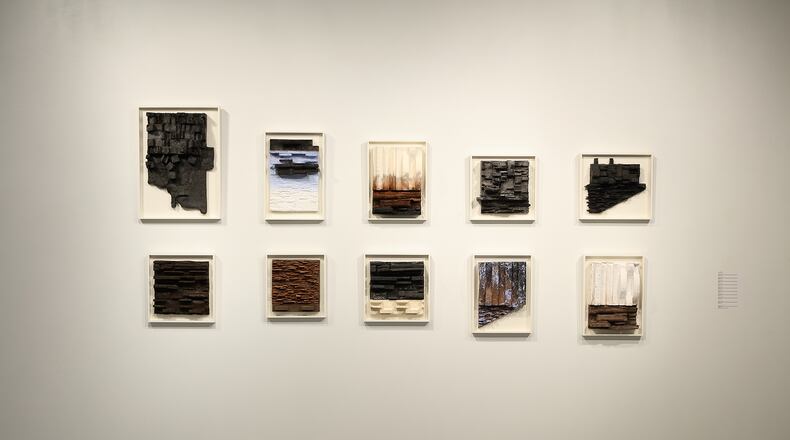Leonardo Drew has often described a moment in 1992 when he pushed a large bale of cotton down 30 streets in Manhattan to his teacher Jack Whitten’s studio. This was not a performance, but a practical way to get the cotton material he needed to the studio for the sculptures he would make for an exhibition.
However, the implications of a young African American male pushing a bale of cotton were not lost on Drew or Whitten. The connotations of identity and history that inform his work are embedded in its materials and his process of making it.
Drew’s contemporaries Mark Bradford and Rodney McMillian have both delved into abstraction by repurposing found objects that speak to the African-American male experience. Drew, however, is quite different. His reliefs and sculptures emulate found and discarded objects but are made in the studio.
Credit: Mike Jensen
Credit: Mike Jensen
Except for one work for which he paid homeless people to collect debris from the streets, Drew employs new materials, which he often paints black or another solid color to give them the patina of a charred surface that has been repurposed. This is a significant difference, both in the presence of the work and in its process and concept.
“Leonardo Drew: Cycles,” at the Zuckerman Museum of Art through May 7, has been traveling to university art museums for the last several years. It primarily features works made as editions, on loan from the collection of the Oregon-based Jordan D. Schnitzer Family Foundation.
Schnitzer’s collection contains more than 19,000 artworks. He first saw Drew’s work at an international print fair in 2017 and was instantly entranced by both the work and the artist. He quickly added Drew’s works to his vast collection.
In this elegant exhibition, all the artworks are abstract compositions in subtle palettes of black, silver, whites, browns and blues. The titles are combinations of numbers and letters made seemingly for bookkeeping purposes.
There is a suite of 10 very handsome editioned works in handmade cast paper with hand-applied pigment from 2017. They are small: Most are around 15 1/2 x 11 x 3 3/4 inches, and titled “62P” through “71P.” These individually framed works, in relief and bulging and receding in graceful abstraction, are stunning.
Hung together, they work both individually and collectively as part of the suite. Drew has acknowledged his love for Piet Mondrian and that artist’s geometric grid is evident here. Their physicality belies their small scale, allowing for a kind of intimacy.
Although most of the works here are multiples, four unique pieces have a different presence. “Number 134D,” 2012, in a Plexiglas box hung on the gallery wall, is made of wood, paint chips and graphite on paper. A small assemblage, it has an explosive composition that depicts natural elements and distills the artist’s large installations.
“Number 142L,” 2018, is a large, square wall relief almost 4 inches deep. It was made by collaging pieces of wood, each painted a soft and warm black, creating a dynamite assemblage of shape and movement.
Drew is known for collages made with new wood that he cuts and patinas with a soft and deep velvety black paint. He acknowledges Mondrian and Jackson Pollock as heroes, but one wonders how much he’s been inspired by Louise Nevelson, one of the great woman artists of the 20th Century — she made sculptural reliefs in collaged wood pieces painted in her signature matte black. (Pace Prints of New York, which publishes Drew’s prints, recently presented a show of Nevelson’s cast paper pulp reliefs.)
Drew’s cast paper prints, etchings and aquatints at the Zuckerman are extremely pleasing to the eye. This ultimately is a problem. The power, immediacy and energy of Drew’s large-scale installations are diminished in this presentation. The artist’s concepts of personal narrative in relation to history have been softened and the brutalist nature of his work becomes undemanding as it leans toward the decorative. Unfortunately, this is the opposite of what the artist is endeavoring.
Drew has said of himself, “I am the weather,” in emulation of Pollock, who famously said, “I am nature.” In the print-heavy “Cycles,” one wants more weather and more of the tumult and energy of the artist’s large installations. The process of reducing his work to small-scale collectible prints has betrayed its power.
Deanna Sirlin is an artist and writer. She is known internationally for large-scale installations that have covered the sides of buildings from Atlanta to Venice, Italy. Her book, She’s Got What It Takes: American Women Artists in Dialogue, (2013) is a critical yet intimate look at the lives and work of nine noted American women artists who have been personally important to Sirlin.
The exhibit
“Leonardo Drew: Cycles” is at the Zuckerman Museum of Art through May 7
Credit: Mike Jensen
Credit: Mike Jensen
Credit: ArtsATL
Credit: ArtsATL
MEET OUR PARTNER
ArtsATL (www.artsatl.org), is a nonprofit organization that plays a critical role in educating and informing audiences about metro Atlanta’s arts and culture. Founded in 2009, ArtsATL’s goal is to help build a sustainable arts community contributing to the economic and cultural health of the city.
If you have any questions about this partnership or others, please contact Senior Manager of Partnerships Nicole Williams at nicole.williams@ajc.com.
About the Author
The Latest
Featured





